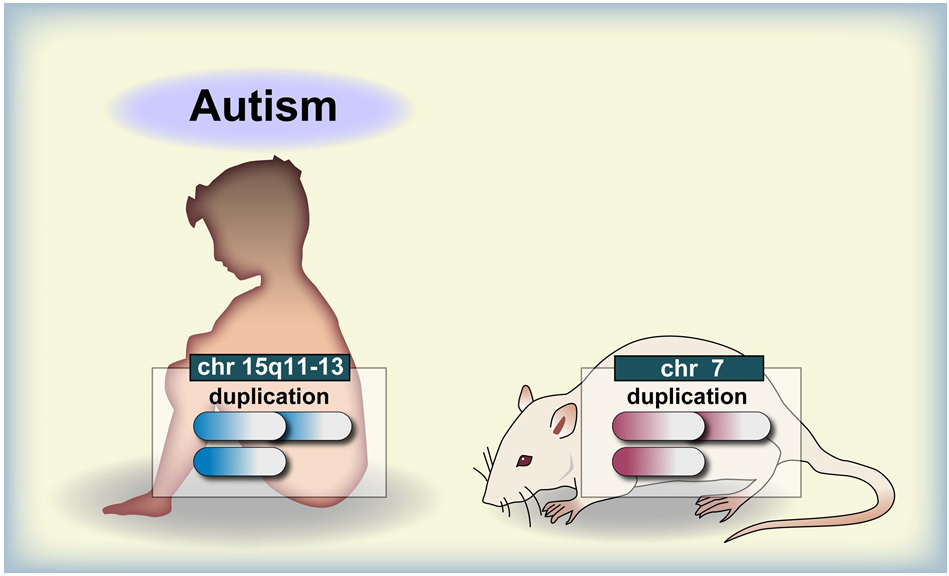|
Mouse model of human 15q11–13 duplication B6.129S7-Dp(7Herc2-Mkrn3)1Taku (RBRC05954)Courtesy of Toru Takumi, M.D., Ph.D. The mouse contains CNV (copy number variation, duplication) in mouse chromosome 7, mirroring duplication of human chromosome 15q11–13. |
| A common feature of autism spectrum disorder (ASD) is neurodevelopmental impairment, which is characterized by difficulties with social interactions and communication and by repetitive or rigid behavior. In the latest edition of the Diagnostic and Statistical Manual of Mental Disorders, three subgroups (autism, Asperger syndrome, and pervasive developmental disorder not otherwise specified) were merged into the single term of ASD [1, 2].
Among a variety of copy number variations found in ASD patients, duplication of 15q11–13 has been reported most frequently. This is also an imprinting region where deletions or methylation abnormalities lead to Prader-Willi syndrome, Angelman syndrome, or ASD. A mouse model of human 15q11–13 duplication was generated by chromosomal engineering based on the Cre-loxP system and has a 6.3-Mb duplicated locus in chromosome 7c, which is highly similar to human 15q11–13 [3]. Mice carrying a paternally inherited duplication (patDp/+ mice) display autistic phenotypes such as decreased sociability, behavioral inflexibility, decreased spontaneous activity, and increased anxiety [3–7]. |
| Depositor | : | Toru Takumi, M.D., Ph.D. Laboratory for Mental Biology RIKEN Brain Science Institute |
|
| Strain name | : | B6.129S7-Dp(7Herc2-Mkrn3)1Taku | |
| RBRC No. | : | RBRC05954 | |
| References | : | [1] | Liu X, Takumi T. Genomic and genetic aspects of autism spectrum disorder. Biochem Biophys Res Commun.; 452(2):244-53, 2014. |
| [2] | Nomura J, Takumi T. Animal models of psychiatric disorders that reflect human copy number variation. Neural Plast.; 2012:589524, 2012. | ||
| [3] | Nakatani J, Tamada K, Hatanaka F, Ise S, Ohta H, Inoue K, Tomonaga S, Watanabe Y, Chung YJ, Banerjee R, Iwamoto K, Kato T, Okazawa M, Yamauchi K, Tanda K, Takao K, Miyakawa T, Bradley A, Takumi T. Abnormal behavior in a chromosome-engineered mouse model for human 15q11-13 duplication seen in autism. Cell; 137(7):1235-46, 2009. | ||
| [4] | Tamada K, Tomonaga S, Hatanaka F, Nakai N, Takao K, Miyakawa T, Nakatani J, Takumi T. Decreased exploratory activity in a mouse model of 15q duplication syndrome; implications for disturbance of serotonin signaling. PLOS ONE; 5(12):e15126, 2010. | ||
| [5] | Piochon C, Kloth AD, Grasselli G, Titley HK, Nakayama H, Hashimoto K, Wan V, Simmons DH, Eissa T, Nakatani J, Cherskov A, Miyazaki T, Watanabe M, Takumi T, Kano M, Wang SS, Hansel C. Cerebellar plasticity and motor learning deficits in a copy-number variation mouse model of autism. Nat Commun.; 5:5586, 2014. | ||
| [6] | Isshiki M, Tanaka S, Kuriu T, Tabuchi K, Takumi T, Okabe S. Enhanced synapse remodelling as a common phenotype in mouse models of autism. Nat Commun.; 5:4742, 2014. | ||
| [7] | Ellegood J, Nakai N, Nakatani J, Henkelman M, Takumi T, Lerch J. Neuroanatomical phenotypes are consistent with autism-like behavioral phenotypes in the 15q11–13 duplication mouse model. Autism Res.; Mar 7, 2015 [Epub ahead of print]. | ||
| April 2015 Contact: Shinya Ayabe, Ph.D. Experimental Animal Division, RIKEN BioResource Center All materials contained on this site may not be reproduced, distributed, displayed, published or broadcast without the prior permission of the owner of that content. |






